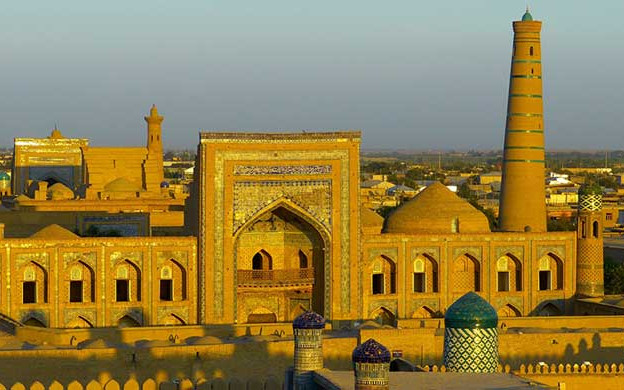L'Ouzbékistan, joyau de la Route de la Soie
Explorez l'Ouzbékistan, terre de merveilles ancestrales.
Découvrez des cités légendaires et des paysages à couper le souffle.
Ouzbékistan : un voyage entre histoire et modernité fascinante
À mi-chemin entre l’Europe et la Chine, sur l’ancienne Route de la soie dépeinte au XIIIe siècle par Marco Polo dans son « Livre des merveilles », s’étendent des espaces infinis de steppe et de désert, bordés de montagnes aux cimes enneigées et de lacs salés comme le lac Aydar, jusqu’aux rivages d’une mer disparue, la mer d’Aral. D’Alexandre Le Grand aux tsars russes, en passant par le grand empereur mongol Gengis Khan et Tamerlan, le "Touran", le peuple ouzbek a vu naître, s'affronter, cohabiter ou mourir les plus grands empires!
Partir en Asie centrale à la découverte de l’Ouzbékistan, c’est se retrouver au carrefour des civilisations et des religions, pour vivre une expérience unique dans des contrées encore peu explorées par les circuits touristiques. Une agence locale pourra vous préparer un voyage sur mesure en Ouzbékistan, inoubliable. Un séjour en Ouzbékistan fait partie de ces voyages culturels qui sortent des sentiers battus.
Un voyage à travers le temps et l'espace
Décors immenses à travers les contreforts du Pamir et trésors de l'architecture musulmane médiévale, vous serez séduit par le charme de l'un des plus beaux héritages architecturaux au monde lors de votre voyage en Ouzbékistan.

Les trésors incontournables à découvrir
Remontez le temps à Samarcande. La capitale brille par le gigantisme de ses monuments parmi les plus grands d'Asie centrale. Cité légendaire de la Route de la soie, Samarkand a conservé bon nombre de ses trésors de l’architecture musulmane, dont la colossale mosquée Bibi Khanum avec ses deux minarets, le mausolée du Gour Emir ou encore le complexe de la nécropole de Shah-i-Zinda. Sur la monumentale place du Réghistan, entre deux madrasas et une mosquée, laissez-vous entraîner dans le passé et imaginez l’effervescence du lieu lorsque c’était le grand marché du monde, où se croisaient les plus précieux trésors venus de tous les royaumes et empires.
Retranchez-vous au sein de la ville fortifiée de Itchan Kala. Le Khanat de Khiva est la plus ancienne région ouzbèke. Le quartier de la vieille ville de Khiva est une fascinante cité fortifiée de 600 m sur 400 m, un savant puzzle où les architectes ont su imbriquer au fil des siècles toujours plus de bâtiments dans un espace aussi fermé. Ne manquez pas le Caravanserail de Allakouli-khan où les commerçants avaient l’habitude de s’arrêter en provenance de Boukhara, de Perse, d’Inde et de Russie.
Appréciez l’authenticité de Boukhara. Oasis accueillante aux portes du désert rouge de Kyzyl Kum (étendue de dunes à mi-chemin entre désert et steppes), Boukhara a su se distinguer en préservant son patrimoine architectural hérité de plus de 15 siècles d’histoire. Une ambiance hors du temps, digne des grands explorateurs. Vieilles pierres, murs en pisé, minarets et dômes turquoise, ici rien ne vous rappelle que vous êtes au 21e siècle ! Les caravanserails sont toujours là et dans les Tim (échoppes couvertes), les artisans perpétuent la tradition.

Découverte de l'Ouzbékistan authentique
Découvrez les vestiges de la mer d'Aral. Il y a 50 ans, c'était encore le quatrième plus grand lac du monde. Aujourd'hui, asséchée en grande partie à cause du détournement de deux fleuves en amont, la mer d'Aral se traverse à pied ou en 4x4 et expose au grand jour de nombreux vestiges antiques et modernes.
Dévalez les pistes à la station de ski de Chimgam, située à 80 km au nord-est de Tachkent. Chimgam devient en hiver la station de ski de la capitale. Une neige réputée pour ses qualités de glisse vous attend alors sous le regard bienveillant du sommet du Grand Chimgam, culminant à 3 309 mètres.
Au cœur de la culture ouzbèke dans la vallée de Ferghana, qui couvre l'est de l'Ouzbékistan, le sud du Kirghizistan et le nord du Tadjikistan. Cette magnifique vallée est arrosée par les eaux des fleuves Syr-Daria et Narin. Le cœur social du pays bat dans cette vaste plaine fertile de 300 km. C'est la région restée la plus proche des traditions, où l'influence de la religion est la plus forte, l'endroit idéal pour partager un thé avec la population locale sous une yourte. N'oubliez pas de visiter Marguilan, le plus grand centre de fabrication de soie du pays ! Il y a également de belles médersas et mosquées à découvrir.
A website by
Customize your trips with Quotatrip and receive tailor-made offers directly in your inbox.
Discover a country
Copyright 2025 © Quotatrip.